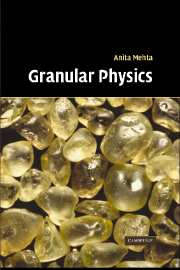Book contents
- Frontmatter
- Contents
- Preface
- 1 Introduction
- 2 Computer simulation approaches – an overview
- 3 Structure of vibrated powders – numerical results
- 4 Collective structures in sand – the phenomenon of bridging
- 5 On angles of repose: bistability and collapse
- 6 Compaction of disordered grains in the jamming limit: sand on random graphs
- 7 Shaking a box of sand I – a simple lattice model
- 8 Shaking a box of sand II – at the jamming limit, when shape matters!
- 9 Avalanches with reorganising grains
- 10 From earthquakes to sandpiles – stick–slip motion
- 11 Coupled continuum equations: the dynamics of sandpile surfaces
- 12 Theory of rapid granular flows
- 13 The thermodynamics of granular materials
- 14 Static properties of granular materials
- References
- Index
- Plate section
12 - Theory of rapid granular flows
Published online by Cambridge University Press: 06 October 2009
- Frontmatter
- Contents
- Preface
- 1 Introduction
- 2 Computer simulation approaches – an overview
- 3 Structure of vibrated powders – numerical results
- 4 Collective structures in sand – the phenomenon of bridging
- 5 On angles of repose: bistability and collapse
- 6 Compaction of disordered grains in the jamming limit: sand on random graphs
- 7 Shaking a box of sand I – a simple lattice model
- 8 Shaking a box of sand II – at the jamming limit, when shape matters!
- 9 Avalanches with reorganising grains
- 10 From earthquakes to sandpiles – stick–slip motion
- 11 Coupled continuum equations: the dynamics of sandpile surfaces
- 12 Theory of rapid granular flows
- 13 The thermodynamics of granular materials
- 14 Static properties of granular materials
- References
- Index
- Plate section
Summary
Introduction
The term ‘rapid granular flows’ is short for ‘rapidly sheared granular flows’. Indeed, the paradigm for a fluidised granular system had been for a long time a strongly sheared granular system, as in the classic experiments of Bagnold. In recent years it seems that the main method of fluidisation in research laboratories is vertical vibration, see, e.g., and, at times, horizontal shaking of collections of grains, see, e.g., or even electromagnetic fluidisation. The fluidised state of a granular assembly is recently referred to as a ‘granular gas’, probably following the terminology introduced in. Although most granular gases on earth are ‘man made’, there are naturally occurring granular gases, as part of snow and rock slides are fluidised. In outer space one finds interstellar dust and planetary rings (the latter being composed of ice particles).
In many cases, the grains comprising a granular gas are embedded in a fluid, hence technically they are part of a suspension. However, as noted by Bagnold, when the stress due to the grains sufficiently exceeds the fluid stress (the ratio of the two is known as the Bagnold number) one can ignore the effect of the ambient fluid (clearly, when the air is pumped out of a granular system, as in, e.g, or when one considers celestial granular gases, one need not worry about the ambient fluid). Suspensions will not be considered in this chapter.
- Type
- Chapter
- Information
- Granular Physics , pp. 176 - 208Publisher: Cambridge University PressPrint publication year: 2007
- 1
- Cited by



